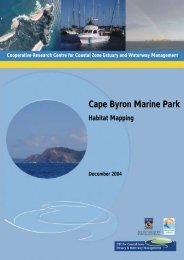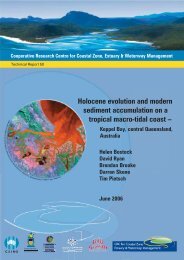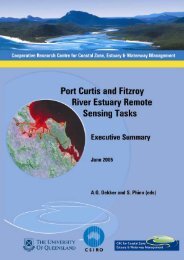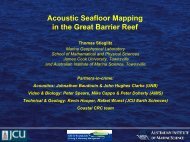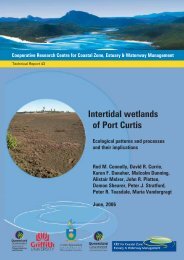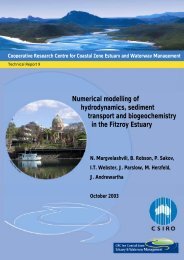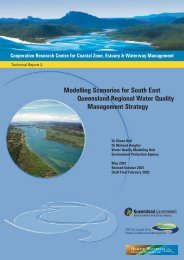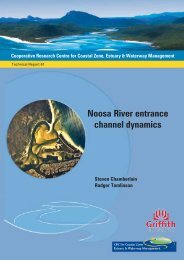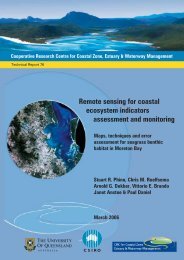The evolution of Jumpinpin Inlet - OzCoasts
The evolution of Jumpinpin Inlet - OzCoasts
The evolution of Jumpinpin Inlet - OzCoasts
You also want an ePaper? Increase the reach of your titles
YUMPU automatically turns print PDFs into web optimized ePapers that Google loves.
<strong>The</strong> <strong>evolution</strong> <strong>of</strong> <strong>Jumpinpin</strong> <strong>Inlet</strong><br />
4.1.6 <strong>Inlet</strong> stability and closure<br />
Some inlets are comparatively permanent features being maintained by tidal<br />
exchange supplemented by storm generated currents, whereas other inlets tend to<br />
close. <strong>The</strong> tendency toward closure is related to the ratio between littoral drift and<br />
tidal flow bypassing <strong>of</strong> sand past the inlet (Stanley & Swift, 1974). When, as the result<br />
<strong>of</strong> a storm the cross-sectional area <strong>of</strong> an inlet is reduced below a certain value, the<br />
tidal currents could become too small to flush the sediment coming into the inlet by<br />
the longshore current. Longshore processes will dominate over tidal flow and the inlet<br />
will close. <strong>The</strong> importance <strong>of</strong> inlet width has been explored by Van De Kreeke (1985;<br />
1990a,b) and is described in terms <strong>of</strong> stability analysis and closure curves.<br />
Stability <strong>of</strong> single inlets deals with the equilibrium between gorge cross-sectional area<br />
and inlet hydrodynamics. From Van De Kreeke (1990a), the parameters <strong>of</strong> stability<br />
are actual tidal maximum <strong>of</strong> the bottom shear stress and the equilibrium shear stress.<br />
<strong>The</strong> equilibrium shear stress is defined as the bottom stress induced by tidal currents<br />
that is required to flush sediments carried into the inlet by longshore currents.<br />
When actual shear stress equals the equilibrium shear stress, the inlet is in<br />
equilibrium with the hydraulic environment. If the actual shear stress becomes larger,<br />
the inlet goes into scouring mode. If equilibrium shear stress is larger the inlet is in<br />
shoaling mode. <strong>The</strong> equilibrium is considered stable if, after changes such as storms,<br />
the inlet cross-sectional area unconditionally returns to its equilibrium value.<br />
For two-inlet bay systems Van De Kreeke (1990a) provides a possible configuration<br />
for equilibrium flow curves (see Figure 4.2). <strong>The</strong> open and closed circles imply four<br />
sets <strong>of</strong> values for which both inlets have cross-sectional areas that are in equilibrium<br />
with the hydraulic environment. Results <strong>of</strong> a stability analysis on a two-inlet bay<br />
system conducted by Van De Kreeke (1985) showed that at best two sets <strong>of</strong><br />
equilibrium flow area can exist. Based on these results, a set <strong>of</strong> stable cross-sectional<br />
areas cannot exist and ultimately one or both the inlets will close.<br />
14





